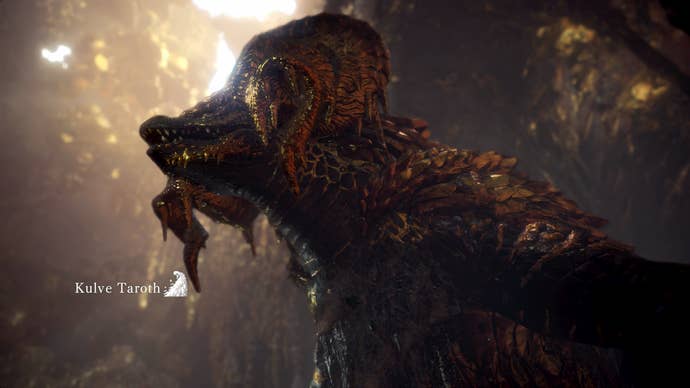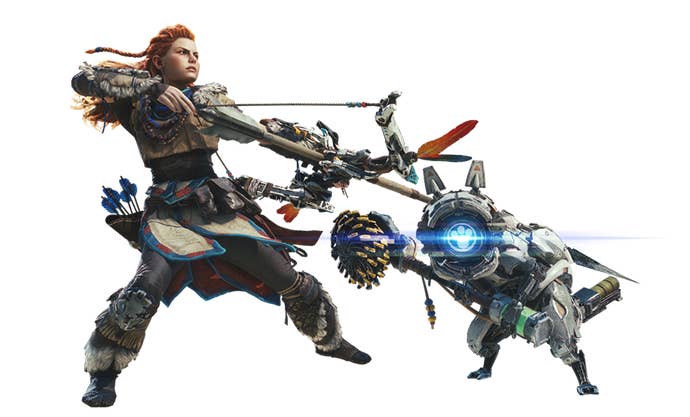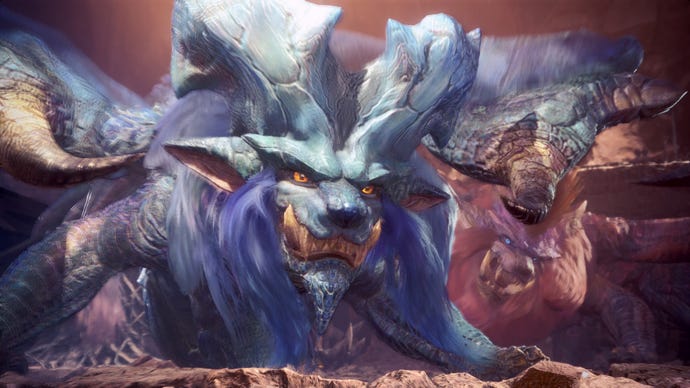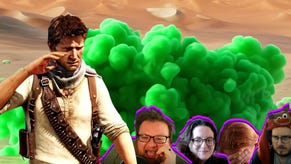Monster Hunter: World Anniversary: How Capcom Has Kept Its Most Successful Game Fresh
It's been a truly standout year for Capcom's biggest game to date.
This article first appeared on USgamer, a partner publication of VG247. Some content, such as this article, has been migrated to VG247 for posterity after USgamer's closure - but it has not been edited or further vetted by the VG247 team.
Monster Hunter: World kicked my ass. Going by the colossal 10.7 million copies sold since it first released back in January 2018, it kicked a lot of people's asses. The Anjanath ate me, the Nergigante crushed me, and the Vaal Hazak filled my lungs with poisonous gas. But, crucially, these were all challenges I could overcome with two critical things: planning and patience. I spent full days trying to master the Nergigante and bend the creature to my will, and a week later, I could practically predict the outcome of every attack it had in its arsenal. This was just the beginning.
Today, over one year after its original release, Monster Hunter: World is Capcom's most successful game ever, and it's still going. The live service model is never easy to sustain, and although Capcom’s drip feed of content has been controversial in some corners of the player base, there’s always new armor and weapon items to craft, new investigations to take, and new scenarios to spiral out of control, every time a new monster is added.

A year of updates kicked off with the Deviljho. Roughly two months after launch, Capcom introduced the enraged lizard-looking creature with rows of razor-sharp teeth in an oversized maw to Monster Hunter: World players, and it tore us apart. Monster Hunter: World featured creatures that we could plan around; we could learn to predict the attacks of Elder Dragons, and we knew our lumbering Great Jagras from our rapid Tobi-Kadachi. So Capcom threw an absolute wild card into the mix with the Deviljho, a ferocious creature that could bound across areas in the blink of an eye, even scooping up other unfortunate monsters in its maw and swinging them around as weapons (a Monster Hunter: World first).
Deviljho is a near unstoppable force of raw fury and power, which even the most seasoned hunters struggled to overcome (and still to this day struggle with, if I’m being honest). Deviljho is a wonderful addition to Monster Hunter: World, and it's completely free of charge. “In this day and age of DLC and microtransactions, there’s a certain expectancy that to play any additional content post-launch you’re likely going to have to part with some cash, but Monster Hunter is different,” YouTuber and Monster Hunter series veteran Arekkz told me. “The addition of a single new monster might not be comparable to a $20 DLC expansion, but regardless it’s content that keeps people coming back time and time again.”
Say Hello to Raids (And the Kulve Taroth!)
Less than a month later, one of the most powerful creatures of them all showed up in Monster Hunter: World: the Kulve Taroth. With the Deviljho, Capcom had introduced only one new creature and integrated it into the wider game. But the Kulve Taroth update in April 2018 introduced a raid-type activity to Monster Hunter: World for the very first time, challenging up to 16 players to band together to tackle the huge beast. In fact, the Kulve Taroth was so big and strong that it was actually impossible to kill it. Your best hope was to repel it for as long within a very short window of time.

Crucially, the Kulve Taroth gave us a new type of mission in Monster Hunter: World. Whereas before you could take on beasts by yourself (if you were feeling brave), the Kulve Taroth Siege Quest forced players to band together in teams if they wanted to stand a chance against the giant golden dragon. “Monster Hunter has been a game you always grind and play on repeat in search of items you want,” Arekkz says. “But with Kulve Taroth, offering up weapons in a less-conventional, RNG [Random Number Generator for dealing out randomised loot] ‘Relic’ system, players had yet more reason to grind.”
Not only was the Kulve Taroth something entirely fresh and new, but once again, Capcom didn’t lock off the golden Elder Dragon behind hours of grinding out activities repeatedly. All you had to do was find a few tracks of the Kulve Taroth out in the open-world, and you were golden to kick off the new raid. It was simple but effective, and kept a dedicated player base together in the months following the global launch.
The Ever Changing Meta of Monster Hunter: World
The following month, the ferocious Lunastra landed in Monster Hunter: World. The fiery cousin of the Elder Dragon Teostra, the Lunastra presented a brand new challenge for veteran players in that it could pair up with the Teostra, making one hell of a one-two punch for any unfortunate hunters going up against both creatures at once. Then the aptly-named Behemoth was introduced to Monster Hunter: World. As part of a collaboration event with Final Fantasy 14, Capcom borrowed the beast from Eorzea so it could pummel poor hunters into the ground.

If you’ve already reached the peak of Monster Hunter: World, bending an Elder Dragon to your will is like taking an old dog for a walk—your opposition doesn’t want it to happen, but the outcome is inevitable. Although somewhat of a reskinned Teostra, facing down against not only the Lunastra but also the Teostra was an intense challenge for even the most skilled and daring Monster Hunter players. It’s one I've still yet to conquer.
The Behemoth wrecked the meta of Monster Hunter: World in a different way. It was a challenge that only the most experienced Monster Hunter: World players, working in tandem as a solid team of four players, could hope to overcome. It was Kulve Taroth-levels of tough, without requiring a whole 16 players to bring down. “Behemoth was quite possibly the coolest collaboration we’ve seen to date,” Arekkz agreed. For the first time in the whole Monster Hunter series, we had to carefully manage aggravating the monumental Behemoth, because it could take out an entire team of hunters with a devastating single attack. It’s not just new monsters that have kept Capcom’s beast fresh, it’s changes to the very rules of the game itself.
An Event for Every Season
But don’t think that Capcom has sustained player interest for a whole 12 months with four new monsters alone. Sprinkled in the gaps between new creatures arriving on the shores of the New World have been seasonal festivals. Though only active for two weeks at a time, the seasonable festivals have crucially revived missions and quests no longer available to Monster Hunter: World players, all while giving the gathering hub area a fancy seasonal makeover.

Take the Horizon Zero Dawn collaboration quest, for example. If you started playing Monster Hunter: World in January 2018 on the PS4, you had a limited window of opportunity (less than a month) to complete three simple quests. Complete the quests, and you’d be granted armor for your hunter that turned them into Aloy, the protagonist of Horizon Zero Dawn, and an outfit for your Palico that transformed your furry friend into a Watcher robot from the aforementioned game.
But let’s say that you came to Monster Hunter: World a little late on PS4, and you missed the opportunity to unlock Aloy’s armor. During the spring, summer, autumn, and winter festivals in Monster Hunter: World, limited time quests like these were temporarily revived, giving new players an opportunity to catch up and older players a chance to undertake these collaboration quests again if they missed them the first time around. Additional collaborations like Street Fighter 5 have also made a triumphant return during the seasonal festivals in Monster Hunter: World, giving the events meaning beyond a nice new makeover to the main hub area of the game.
All of these events have done a lot to keep Monster Hunter: World fresh. But when it comes down to it, I'm mostly still playing Monster Hunter: World because it's fair, and because it respects my time. With Destiny 2, Bungie lays out new activities in front of you with each new expansion, whether it’s a new Forge or raid, but all of them have an increasingly demanding level requirement, forcing you to grind out activities repeatedly in order to access new activities.
With Monster Hunter: World, there are no such demands. Capcom puts minimal requirements on accessing new monsters like the Lunastra or the Deviljho, asking you to merely undertake a research quest before you face the new beast head-on. It’s never a massive time sink to reach new content.
More importantly, new weapons and armor are always something special. The Deviljho gear gives you the appearance of the demonic pickle-like creature, while the Behemoth armor gives your hunter the finesse of a Final Fantasy-like character. Capcom always plays to both audiences with new content—if you don’t have much time on your hands, you can still get in a few rounds with a new monster; but if you love to embrace the grind, you can sink hours into getting some fancy new weapons.
It’s something that series veterans like Arekkz agree with. “It’s fair to say people always want more, and sometimes that single monster addition might seemingly be over almost as soon as it’s been added, this regular cadence of updates means Monster Hunter: World is a game people can dip in and out of—when they feel like they’ve done it all, they can take a break, and come back again with the next update.”
With one year in the books, Monster Hunter: World is an excellent example of how to sustain a massive player base. Capcom has time and time again given us ample reason to return, and it’s always worth your time. And with the Iceborne expansion due this fall, the future is looking brighter than ever for one of the best games of 2018.




